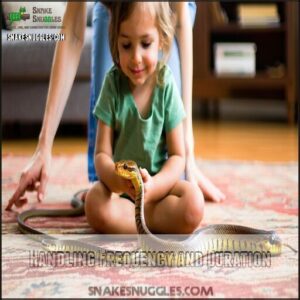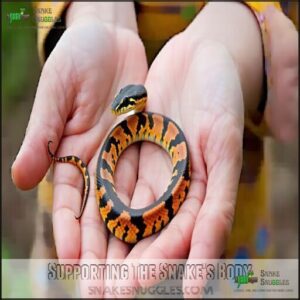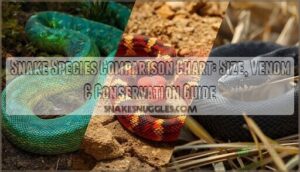This site is supported by our readers. We may earn a commission, at no cost to you, if you purchase through links.
 Corn snakes are great for kids, thanks to their calm nature and manageable size.
Corn snakes are great for kids, thanks to their calm nature and manageable size.
When handling, always support the snake’s body with both hands. Approach slowly and avoid quick movements that could spook it.
It’s best to supervise kids closely to guarantee safe interactions. Teach them to handle gently and not squeeze, as snakes don’t enjoy tight hugs!
A well-fed, calm snake is usually easier to handle, so timing matters too. Watch for stress signs, like rapid tongue flicking or trying to hide.
With patience and care, handling can be safe and fun—plus, it builds trust with your slithery friend!
Table Of Contents
- Key Takeaways
- Choosing Kid Friendly Snakes
- Safety Considerations
- Corn Snake Handling Basics
- Taming and Acclimating
- Handling and Care Tips
- Handling Mistakes to Avoid
- Frequently Asked Questions (FAQs)
- Are corn snakes friendly to kids?
- What is the easiest pet snake for kids?
- Do corn snakes like to be touched?
- How do corn snakes interact with other pets?
- What to do if a corn snake escapes?
- Are corn snakes suitable for first-time owners?
- How often should a corn snake’s water be changed?
- Can corn snakes recognize their owners over time?
- Conclusion
Key Takeaways
- Handle your corn snake gently with both hands and avoid squeezing or quick movements to keep it calm and stress-free.
- Always supervise kids during handling sessions to ensure safety and teach them proper techniques like supporting the snake’s body.
- Avoid handling your snake after feeding or during shedding periods to prevent stress or regurgitation.
- Watch for stress signals like an S-shaped neck or rapid tongue flicking, and give your snake space when needed to maintain trust.
Choosing Kid Friendly Snakes
You’ll find that corn snakes, ball pythons, and garter snakes make excellent first pets for children due to their gentle temperaments and manageable size.
When selecting a snake for your child, consider both the snake’s adult size and its expected lifespan of 15-30 years to confirm you’re ready for the long-term commitment.
Picking a pet snake means committing for 15-30 years—make sure you’re ready for a lifelong scaly companion.
Corn Snake Characteristics
Champions of kid-friendly pets, corn snakes showcase vibrant orange, red, and brown patterns that captivate young eyes.
They’re known for their docile temperament and calm demeanor, rarely becoming aggressive when handled properly.
Their moderate activity level makes them perfect first reptiles, being most active during dawn and dusk.
Their calm nature makes them easy to handle, even for children, and they grow to a manageable 3-5 feet, living 15-20 years with proper care.
Garter Snake Temperament
Three key aspects make garter snakes interesting beginner pets.
While generally docile, their temperament varies widely between individuals.
- Most garter snakes calm down quickly with regular handling
- They rarely bite, but may musk when stressed
- Their high activity levels make them entertaining for kids
- Individual variation means some are naturally more docile
- Wild-caught specimens typically show more handling challenges than captive-bred
Despite their small size, always supervise kids during snake handling for safety.
Ball Python Handling
While garter snakes are active and wriggly, ball pythons offer a completely different handling experience.
These gentle giants are ideal for kids thanks to their calm ball python temperament. When properly supported, they’ll often sit quietly in your hands.
Teach children proper support techniques—never let the snake dangle! Watch for stress signs like head-hiding or tight coiling.
With weekly handling sessions, ball pythons rarely bite, making them excellent first reptiles for children, and they are known to have a calm nature, which is a key factor in their gentle giants reputation.
Safety Considerations
You’ll need to watch your corn snake’s body language and follow basic safety steps to keep both your child and the snake happy.
Washing hands before and after handling, supporting the snake’s whole body, and avoiding contact during feeding or shedding times will help create a safe environment for everyone.
This will ensure that both your child and the snake remain happy and healthy.
Snake Behavior and Body Language
Now that you’ve chosen a kid-friendly snake, understanding their body language is key to safe handling.
Your corn snake uses clear signals to communicate, such as tongue flicking, which means they’re exploring, while a coiled neck in an S-shape indicates they feel threatened.
During shedding behavior, their eyes turn cloudy and they may be more defensive, and you should also watch for musk signals (releasing odor) which show stress.
These defensive postures help you know when to give your snake space.
Handling and Safety Precautions
After washing hands thoroughly, always supervise kids during corn snake handling sessions.
Support the snake’s entire body and avoid grabbing near the head. Never let children handle snakes unsupervised, as this prevents both bite incidents and stress to the snake.
For added safety, consider using specialized handling equipment.
Keep handling sessions brief (5-10 minutes) for young children. Remember, safe handling practices protect both your child and your scaly friend, ensuring a positive experience with minimal risk.
Common Health Issues in Pet Snakes
While corn snakes are relatively hardy pets, you’ll need to watch for common health issues that could affect your child’s snake.
Regular veterinary checkups help catch problems early. One such issue can be infectious stomatitis, often caused by poor enclosure hygiene.
Watch for these snake diseases:
- Respiratory infections (wheezing, mucus discharge)
- Mouth rot (swelling, discoloration of gums)
- Scale rot (belly discoloration from damp conditions)
- Internal parasites (weight loss, abnormal stool)
These health issues can be managed with proper care, including regular checkups and a clean environment, to prevent common health issues and ensure your pet remains healthy.
Corn Snake Handling Basics
You’ll find corn snakes are one of the easiest reptiles for kids to handle, thanks to their calm nature and manageable size.
Corn snakes are perfect for kids—calm, beautiful, and easy to handle, making them an ideal first reptile pet.
When you pick up your corn snake, always support its body properly and move with gentle, confident motions to help your new scaly friend feel secure.
Approach and Handling Techniques
Approaching your corn snake from the side, rather than from above, helps prevent startling your scaly friend.
Always use calm movements and gently tap the enclosure before handling. For kids, proper hand placement is vital—teach them to scoop the snake’s body with both hands, supporting its weight from underneath. Never grab the head or tail.
Adult supervision is essential for all corn snake handling sessions with children. Be aware that musking indicates stress and handling should cease if this occurs.
Handling Frequency and Duration
Now that you know how to approach your corn snake, let’s talk about how often and how long to handle it.
Finding the right balance keeps your snake comfortable and helps kids build confidence.
Here’s what works for most corn snakes:
- Handle 1-2 times weekly (never daily)
- Keep sessions short: 5-10 minutes for beginners
- Skip handling during shedding periods
- Extend duration gradually as trust builds
- Adjust frequency based on your snake’s unique behavior
This approach ensures a positive experience for both you and your pet, making handling a enjoyable and educational activity.
Supporting The Snake’s Body
Now that you’ve established a good handling routine, let’s focus on proper body support. Always use two hands when holding your corn snake, providing support along its entire length.
Never let the snake dangle, as this can cause spinal injuries. Your hands should serve as a moving platform—imagine them as stepping stones for your snake to glide across.
For snakes with injuries, consider using a reptile support sling to aid in their recovery. This gentle handling guarantees both safety and comfort.
Taming and Acclimating
You’ll need to give your new corn snake about a week to settle into its home before you start handling it.
With patience and gentle, consistent handling sessions of 10-15 minutes a few times weekly, your child’s corn snake will soon become a calm, trusting pet that’s comfortable being held, and with gentle handling, it will become a great companion.
Acclimating New Corn Snakes
When you bring home a new corn snake, patience is your best friend. Give your snake about a week to settle into its new environment before attempting any handling.
A vital step is to establish trust with the snake through patience.
- Inspect the enclosure daily but limit physical interaction during the settling period
- Feed your snake before initial handling to establish positive associations
- Start with brief 5-minute sessions, gradually increasing time as comfort develops
- Keep kids nearby but not handling until your snake shows calm behavior
Building Trust With Your Snake
After your snake has settled in, building trust becomes your next focus.
Start with scent familiarization by placing a worn t-shirt near the enclosure. Practice gentle, consistent handling routines—just 5-10 minutes every other day works well.
Kids should use a slow, calm approach with a positive reinforcement system. Respect your corn snake’s boundaries if it seems uncomfortable.
Trust develops gradually but creates a lasting bond for safe, enjoyable handling experiences.
Recognizing Stress Signs
Now that you’ve started building trust with your corn snake, it’s important to read their body language.
Watch for defensive postures like an S-shaped neck or tail rattling, erratic movements, excessive hiding behavior, and muscle tension are clear indicators your snake feels threatened.
If you notice breathing changes or refusal to eat after handling, give your snake space, as this guarantees safer and more positive snake handling experiences for both kids and reptiles.
Handling and Care Tips
You’ll need to master the basics of corn snake care to keep your scaly friend healthy and happy.
Proper feeding, tank setup, and regular health checks will help your corn snake thrive while teaching your child valuable lessons about animal responsibility.
Feeding and Hydration Guidelines
A successful feeding schedule for your corn snake strikes the perfect balance between too much and too little.
Feed juveniles appropriately sized prey (pinkie or fuzzy mice) every 5-7 days, while adults can eat adult mice every 14-21 days.
Always provide fresh water in a shallow, stable dish.
Consider buying corn snake food from reputable online retailers.
Don’t handle your snake for 48 hours after meals to prevent regurgitation risks.
Enclosure Setup and Maintenance
Now that you’ve established a feeding routine, your corn snake needs a proper home.
Create a temperature gradient (85°F warm side, 75°F cool side) in your enclosure. Choose cypress mulch or aspen shavings as substrate.
Clean weekly with reptile-safe supplies. Maintain humidity levels at 40-60% using a spray bottle.
Safe substrates like aspen shavings help prevent impaction. A 20-gallon tank works for juveniles, but adults need 40+ gallons with hiding spots for enrichment, and a suitable enclosure setup.
Health Checks and Veterinary Care
Regular check-ups are essential for your corn snake’s wellbeing.
Schedule annual vet visits with a qualified reptile vet to catch health issues early.
Watch for signs of respiratory issues (wheezing), mouth rot (gum infections), scale rot (skin lesions), or parasites (lethargy, weight loss).
Transport your snake in a ventilated container for appointments, and bring photos of their enclosure setup to help the vet provide thorough care.
Handling Mistakes to Avoid
You’ll find it easier to build trust with your corn snake when you avoid common handling errors that cause stress or defensive reactions.
Even the friendliest snake can become nervous if you pick it up after feeding or during shedding, so timing your handling sessions correctly keeps both you and your scaly friend happy, which is crucial for building trust.
When Not to Handle Corn Snakes
Now that you’ve mastered the basics of corn snake care, knowing when to keep your hands off is just as important.
Don’t handle your corn snake for at least 48 hours after feeding—this respects their digestive process and prevents regurgitation.
During shedding (when eyes look cloudy blue), your snake’s sensitivity is heightened, and also avoid handling when they show temperament changes like defensive posturing or frequent hiding.
These moments of space maintain safety for both kids and snakes, to help the snake feel secure, remember to provide secure hiding spots, which is crucial for their well-being.
Avoiding Defensive Behavior
After feeding schedules, let’s focus on avoiding defensive behavior.
Corn snakes are friendly but can feel threatened.
- Always use a Safe Approach, moving slowly and calmly.
- Learn Reading Cues like hissing or retreating before handling.
- Encourage a Calm Demeanor during interactions.
- Promote Gentle Handling by supporting their body to guarantee Bite Prevention and enhance snake safety for child-friendly snakes.
Treating Minor Bite Wounds
Snake bites from corn snakes are rare but harmless.
Clean bites with soap and water, then apply antiseptic use like Neosporin. Bandaging wounds helps prevent infection signs like redness or swelling.
Washing hands after handling snakes guarantees snake safety. Watch for irritation, and seek veterinary advice if needed.
A little hand care keeps kids and snakes happy, and remember, a little hand care is essential.
Frequently Asked Questions (FAQs)
Are corn snakes friendly to kids?
Surprisingly, snakes can make great companions for kids.
Corn snakes are gentle, non-venomous, and calm, making them a safe choice.
They’re easy to handle with supervision and help teach responsibility through their low-maintenance care.
What is the easiest pet snake for kids?
Corn snakes are the easiest pet snakes for kids.
They’re gentle, low-maintenance, and adapt well to handling.
Plus, their manageable size and calm nature make them perfect for young beginners learning about snake care.
Do corn snakes like to be touched?
Don’t beat around the bush—corn snakes don’t love being touched, but they do tolerate it well if handled gently and respectfully.
Regular, calm handling helps them stay comfortable, making them great for responsible owners who understand that they should be handled with care, and that gentle interaction is key to their well-being.
How do corn snakes interact with other pets?
You’ll find corn snakes usually quite indifferent to other pets.
They prefer their own space, so minimize interactions.
Curious cats or dogs might stress them out, so always supervise and keep their enclosure secure.
What to do if a corn snake escapes?
If your corn snake pulls a Houdini, start by checking warm, dark spots like under furniture or inside closets.
Set a hide with water nearby, and you’ll likely spot it exploring within days.
Are corn snakes suitable for first-time owners?
They’re great for first-time owners.
Easy to care for, docile, and low-maintenance, these snakes thrive with basic attention.
Plus, their manageable size and calm nature make them perfect for learning reptile care without stress.
How often should a corn snake’s water be changed?
Ever wonder how often to change your snake’s water?
Aim for fresh water daily to keep it clean and safe.
Dirty water can harbor bacteria, so stay ahead and keep your corn snake healthy!
Can corn snakes recognize their owners over time?
Snakes don’t recognize owners like dogs or cats do, but they get familiar with your scent and handling.
Over time, they associate you with safety and care, making them more relaxed during interactions.
Conclusion
Studies show corn snakes rank as one of the top pet reptiles for kids, thanks to their calm temperament and easy care.
By following simple steps like supporting their body, handling gently, and watching for stress, you can create safe, fun interactions.
Always supervise handling sessions and teach kids to respect these fascinating creatures, which is crucial for a rewarding experience that builds trust and strengthens the bond with your pet.
- https://www.youtube.com/c/LoriTorriniAnimalBehavior
- https://www.reptifiles.com/corn-snake-care-guide/corn-snake-diseases-health/corn-snake-shedding/
- https://reptifiles.com/corn-snake-care-guide/corn-snake-food/
- https://pangovet.com/pet-breeds/snakes/snow-corn-snake/
- https://pattonvethospital.com/blog/1151870-three-common-illnesses-of-pet-snakes
















